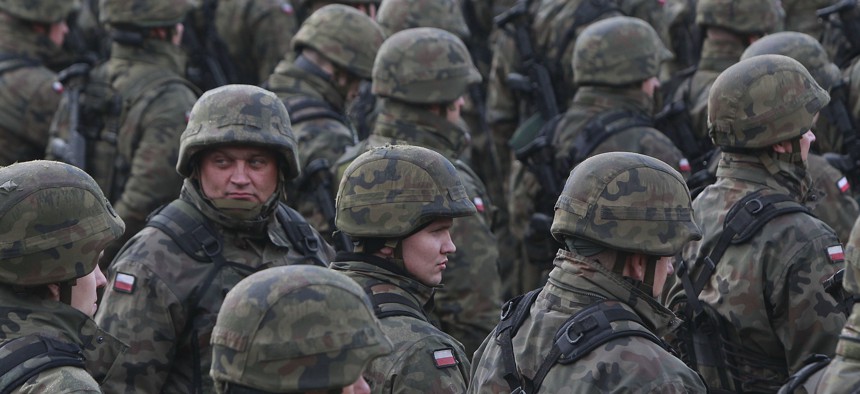
Polish soldiers attend a welcoming ceremony for U.S.-led NATO troops at polygon in Orzysz, northeastern Poland, Thursday, April 13, 2017. AP / Czarek Sokolowsk
Poland Is Preparing for 15 Years of Rising Tension with Russia
The future battles of Eastern Europe will be fought with lasers, cheap missile-drones, and surgical strike units.
Lasers, small drones, and more troops are among the ways Poland is preparing for 15 years of rising tensions — and perhaps even war — with Russia, according to a new report from its Ministry of Defense.
“Taking into account the asymmetry of military capabilities between Russia and NATO’s eastern flank members, such a situation creates a direct threat for Poland and the region,” reads the unclassified summary of the report, published in Polish and English . “It is not unrealistic that Russia could incite a regional conflict and dragging into it one or several NATO countries. Russia is also likely to provoke proxy wars in various parts of the world in order to exert pressure on the Western countries...It is highly probable for Moscow to incite social tensions and frozen conflicts in Armenia, Azerbaijan and Georgia.”
Titled “The Concept of Defence of the Republic of Poland,” the report lays out some key areas of investment for Poland’s military over the next 15 years, including small, kamikaze-style drones for use against Russian radar and lasers to disable enemy missiles and aircraft.
“On drones, we put more stress on simpler and more,” Tomasz Szatkowski, Undersecretary of State for Poland’s Ministry of National Defence said Saturday at the GLOBSEC 2017 Security Forum in Bratislava.
“There is some question about the current strike role of drones. There are some platforms, remotely piloted that you can use quite effectively in Afghanistan and Iraq. But in a highly contested environment, that might be questionable,” he said, referring to the very expensive MQ-9 Reaper drones made famous by counterrorism operations in Afghanistan and Iraq. “So we are thinking of a massive investment in ISR drones and kamikaze drones. We are already developing them and our surgical units are going to be equipped with such technologies, similar to those ISIS is using.”
Gen. Philip Breedlove, a former NATO Supreme Allied Commander Europe who joined Szatkowski for the GLOBSEC forum, said that smaller drones would become cheaper and more effective only through future breakthroughs in machine-to-machine communication, mission vision and autonomous flight. That’s a tall order even in large platforms, much less drones meant to be small enough to evade radar and be disposable.
“What would enable that swarm is machine-to-machine intelligent actions. If one set of machines is already being targeted, don’t keep sending decoys against that specific site and divert the decoys to another site.” What’s needed, he said, was “machine-to-machine conversation that allows our decoys and those penetrating strike weapons to be able to get to the target, learn on their way in, understand who is being targeted and who needs to be released to attack.”
Echoing the report, Szatkowski said Poland intends to invest in heavily in lasers. “I think there is a great promise with the whole aspect of directed energy. Also for second-tier actors” like Poland, he said. “That area may some of the defensive technologies more effective. Ground-based missile defense might become much more cost effective.”
“Some of the aspects of directed energy might allow us to control” how Russia might escalate a given military situation,” Szatkowski said
The new strategy is more than technological. It also calls for more military cooperation with the Visegrad Group of nations: the Czech Republic, Hungary, Poland and Slovakia. “This cooperation should manifest itself in the intensification of exercises, the creation of joint commands and units, and – if possible – in the joint acquisition of military equipment,” the report says.
Poland will also enlarge its military — and in particular, the number of units that can operate semi-autonomously.
“For the first time in 30 years, the number of soldiers and civilian employees will grow significantly. In the next eight years, the total number of Polish Armed Forces will exceed 200,000,” the report says.
Szatkowski added: “Thirty years ago, in 1987, Polish forces of the then-People’s Republic of Poland started to reduce the number of our forces. It took 30 years for us now to reverse.”
NEXT STORY: US Intel Community Launches Face-ID Contest




